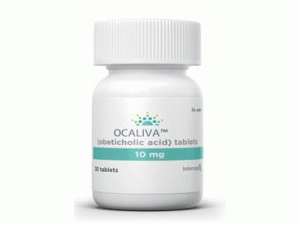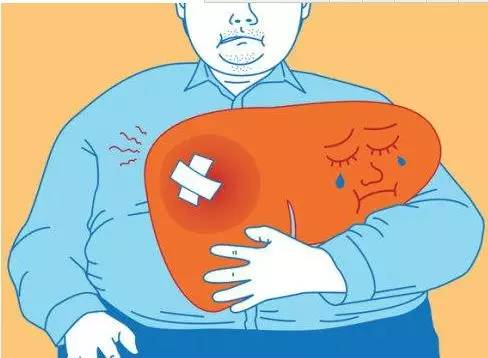奥贝胆酸片obeticholic acid(Ocaliva Tablets 10mg)说明书
 产地国家:美国
处方药:是
所属类别: 10毫克/片 30片/瓶
包装规格: 10毫克/片 30片/瓶
计价单位:瓶
生产厂家英文名:Intercept Pharmaceuticals, Inc
原产地英文商品名:Ocaliva 10mg/tablet 30tablets/bottle
原产地英文药品名:obeticholic acid
中文参考商品译名:Ocaliva片 10毫克/片 30片/瓶
中文参考药品译名:奥贝胆酸
产地国家:美国
处方药:是
所属类别: 10毫克/片 30片/瓶
包装规格: 10毫克/片 30片/瓶
计价单位:瓶
生产厂家英文名:Intercept Pharmaceuticals, Inc
原产地英文商品名:Ocaliva 10mg/tablet 30tablets/bottle
原产地英文药品名:obeticholic acid
中文参考商品译名:Ocaliva片 10毫克/片 30片/瓶
中文参考药品译名:奥贝胆酸
简介
近日,美国FDA加速批准Ocaliva(obeticholic acid,OCA)联合熊去氧胆酸(UDCA)用于UDCA单药治疗应答不佳的原发性胆汁性胆管炎(PBC)成人患者,或单药用于无法耐受UDCA的PBC成人患者。原发性胆汁性胆管炎(PBC)是一种肝内胆小管渐进性损伤的慢性疾病,主要是因胆管遭到自身免疫性破坏,导致胆汁淤积。随时间损伤肝细胞,导致肝硬化和肝脏瘢痕形成。当肝硬化进展和肝中瘢痕组织量增加后,肝脏将丧失其功能。它主要影响女性,目前是美国女性进行肝脏移植手术的第二大病因。在欧洲,该病约占胆汁淤积性疾病所致肝移植病例的一半左右,约占所有肝移植病例的6%。Ocaliva的疗效和安全性监管文件的提交基于一项纳入了216例PBC患者的临床试验。研究显示,相比于对照组,Ocaliva治疗一年后患者的ALP水平降低批准日期:2016年5月31日 公司:InterceptOCALIVA(奥贝胆酸 [obeticholic acid])片剂,用于口服美国最初批准:2016年警告:HEPATIC分离和失败的PBC患者不明原因的PBC患儿B级或C级或分解型CIRROSIS查看完整的盒装警告的完整处方信息在上市后报告中,当OCALIVA给药时,原发性胆管炎(PBC)伴失代偿性肝硬化或Child-Pugh B级或C级肝功能损害的患者报告肝功能失代偿和失败,一些病例致命经常比推荐。对于患有Child-Pugh B级或C级肝功能损害或先前失代偿事件的患者,推荐的OCALIVA起始剂量为每周一次5mg。 作用机制 Obeticholic acid是FXR的激动剂,FXR是在肝脏和肠中表达的核受体。FXR是胆汁酸,炎症,纤维化和代谢途径的关键调节剂。FXR活化通过抑制胆固醇的从头合成以及通过增加胆汁酸从肝细胞中的转运来降低胆汁酸的细胞内肝细胞浓度。 这些机制限制了循环胆汁酸池的整体化,同时促进了胆汁淤积,从而减少了肝脏暴露于胆汁酸。 适应症和用法 OCALIVA,一种法尼醇X受体(FXR)激动剂,适用于治疗原发性胆汁性胆管炎(PBC)和熊去氧胆酸成人对UDCA的反应不充分,或对无法耐受UDCA的成人进行异常治疗的酸(UDCA)。基于碱性磷酸酶(ALP)的减少,该指示在加速批准下被批准。尚未确定存活率或疾病相关症状的改善。对该指征的持续批准可能取决于对临床益处未确认试验的验证和描述。 剂量和给药 重要剂量和管理说明。在疑似肝硬化患者中开始OCALIVA之前,使用眼图计算Child-Pugh分类(A,B或C)并确定合适的起始剂量。为观察到的结果得分参数 1分 2分 3分脑病等级 没有 1或2 3或4腹水 缺席 轻微 中等血清胆红素(mg/dL) <2 2或3 >3血清白蛋白(g/dL) >3.5 2.8到3.5 <2.8国际标准化比率(INR)<1.7 1.7到2.3 >2.3通过添加来自所有5个参数的点来获得Child-Pugh类以获得总分,其可以在5到15个点之间。总分:5-6分=A,7-9分=B,10-15分=C.在OCALIVA治疗期间常规监测患者的生化反应,耐受性,PBC疾病的进展,并重新评估ChildPugh分类以确定是否需要调整剂量。对于进展为晚期疾病的患者(即Child-Pugh A级),将给药频率从每日一次减少至每周一次。到Child-Pugh B级或C级)。 推荐的剂量方案OCALIVA的推荐起始剂量和滴定方案,对于适当剂量的UDCA至少1年没有达到足够生化反应或对URCA不耐受的住院患者,依赖于疾病阶段。分期/分类 非肝硬化或补偿性ChildPughClass A. Child-Pugh B级或C或患者与先前失代偿期活动前3个月开始使用OCALIVA剂量 每日一次5毫克 每周一次5毫克OCALIVA DosageTitration 每日一次10毫克 每周两次5毫克(至少相隔3天)在前3个月后,对于尚未达到ALP和/ 滴定至10毫克每周两次(至少每周一次)或总胆红素充分减少并且正在服用 相隔3天,回应和耐受性OCALIVAb的患者最大OCALIVA剂量 每日一次10毫克 每周两次10毫克(至少相隔3天)a.胃食管静脉曲张破裂出血,新发或恶化的黄疸,自发性细菌性腹膜炎等b.在剂量调整之前,重新计算Child-Pugh分类监测安全,治疗中止。定期监测所有患者的PBC疾病进展。减少从Child-PughClass A升入Child-Pugh B级或C级的患者的给药频率。密切监测肝脏失代偿风险增加的患者。实验室患者的中断治疗或肝功能恶化的临床证据表明失代偿的风险和监护功能。考虑在经历临床上显着的肝脏相关不良反应的患者中停用OCALIVA。难治性瘙痒症患者的管理查看管理选项的完整处方信息。管理说明带或不带食物。对于服用胆汁酸结合树脂的患者,服用胆汁酸结合树脂至少4小时或服用胆汁酸结合树脂后4小时服用OCALIVA,或尽可能长时间服用OCALIVA。 剂量形式和强度 片剂:5mg,10mg 禁忌症 完全性胆道梗阻的患者 警告和注意事项 Child-Pugh B级或C级或失代偿性肝硬化的PBC患者的肝功能失代偿和失败:常规监测患者PBC疾病进展,包括肝脏相关并发症,实验室和临床评估。可能需要进行剂量调整,中断或停止。停止发生完全性胆道梗阻的患者。严重瘙痒症:管理策略包括添加胆汁酸结合树脂或抗组胺药; OCALIVA剂量减少和/或临时剂量中断。降低HDL-C:监测治疗期间血清脂质水平的变化。 不良反应 最常见的不良反应(≥5%)是:瘙痒,疲劳,腹痛和不适,皮疹,口咽疼痛,头晕,便秘,关节痛,甲状腺功能异常和湿疹。 药物相互作用 华法林:INR降低的可能性;监测INR并根据需要调整华法林的剂量,以维持目标INR范围。具有窄治疗指数的CYP1A2底物(例如,茶碱和噻嗪):增加暴露于CYP1A2底物的可能性;用窄治疗指数监测CYP1A2底物的药物浓度。 用于特定人群 肝功能损害:患有Child-Pugh-B级和C级或之前的失代偿期患者需要调整剂量。 包装提供/存储和处理 OCALIVA片剂包装在40 mL高密度聚乙烯瓶中,瓶子上装有33个含有感应密封的聚丙烯儿童防护帽。 每瓶含有30片。5毫克片剂OCALIVA片剂有灰白色至圆形片剂,一面是INT,另一面是5片。每片含有5mg的obeticholic acid。NDC 69516-005-30 5毫克片装一瓶(30支)10毫克片剂OCALIVA片剂可以是灰白色,三角形片剂,一面是INT,另一面是10片。每片含有10mg的obeticholic acid。NDC 69516-010-30 10毫克片装一瓶(30支)存储和处理储存在20ºC-25ºC(68ºF-77ºF); 允许偏移15ºC-30ºC(59ºF-86ºF)[见USP ControlledRoom温度]。英文版说明书
Grants Accelerated Approval to Ocaliva (Obeticholic Acid) for the Treatment of Patients with PBCU.S. Food and Drug Administration (FDA) has granted accelerated approval to Ocaliva (obeticholic acid) for the treatment of primary biliary cholangitis, previously known as primary biliary cirrhosis (PBC), in combination with ursodeoxycholic acid(UDCA) in adults with an inadequate response to UDCA or as monotherapy in adults unable to tolerate UDCA. Ocaliva is an agonist of the farnesoid X receptor (FXR), a nuclear receptor expressed in the liver and intestine and a key regulator of bile acid, inflammatory, fibrotic and metabolic pathways."Intercept was founded on the belief that targeting FXR would benefit patients with liver diseases for which there are limited or no treatment options, and Ocaliva's approval marks the culmination of more than a decade of work," said Mark Pruzanski, M.D., Chief Executive Officer and President of Intercept. "We are very pleased that the FDA has approved Ocaliva for PBC and would like to thank all the patients and investigators around the world who participated in our clinical trials to make this possible."This indication is approved under accelerated approval based on a reduction in alkaline phosphatase (ALP). An improvement in survival or disease-related symptoms has not been established. Continued approval for this indication may be contingent upon verification and description of clinical benefit in confirmatory trials."Ocaliva fills an important unmet need for the many patients with PBC who have an inadequate response to or are intolerant of UDCA, which until now has been the only approved treatment," said John Vierling, M.D., F.A.C.P., F.A.A.S.L.D., Professor of Medicine and Surgery at Baylor College of Medicine and Past President of the American Association for the Study of Liver Diseases (AASLD). "Ocaliva has demonstrated a clinically meaningful improvement in lowering ALP, a liver enzyme and biomarker that is used to track disease progression in patients with PBC. Importantly, Ocaliva maintained durable ALP reductions, which is critical for treatment of a chronic disease like PBC."In Intercept's Phase 3 POISE trial, Ocaliva administration in combination with UDCA (or as monotherapy in UDCA-intolerant patients) met the primary composite endpoint in 46% of patients in the titration group, as compared to 10% of those receiving placebo added to UDCA (p<0.0001). Pruritus (itching), a common symptom of PBC that is unrelated to disease stage or outcomes, was the most common side effect observed in Ocaliva-treated patients. However, pruritus associated with Ocaliva treatment was generally less in patients who were on the dose titration regimen (5 mg once-daily increasing to 10 mg once-daily); one patient (1%) in the titration group discontinued from the study due to pruritus. Additional side effects observed during the trial included fatigue, abdominal pain and discomfort, rash, oropharyngeal pain, dizziness, constipation, arthralgia, thyroid function abnormality and eczema."PBC affects people in the prime of their lives and, for some, the potential need for a liver transplant is a constant concern during these important years," said Linie Moore, a PBC patient and President of the PBCers Organization, the leading PBC patient support group in the U.S. "After nearly two decades with only one approved treatment, we are thrilled to welcome this important new medicine for people living with PBC."Ocaliva is expected to be available to PBC patients in the U.S. within 7-10 days and will be distributed through a specialty pharmacy network. Intercept is dedicated to helping ensure that people with PBC can access Ocaliva and has launched Interconnect™, a comprehensive and personalized patient support services program. Through Interconnect, dedicated Care Coordinators will guide patients through disease education, treatment support and, for eligible patients, financial assistance options, which may include reimbursement support, co-pay assistance or access to Ocaliva at no cost. For more information about Interconnect Support Services and U.S. Distribution, call 1-844-622-4278 or visit www.Interconnectsupport.com.About Primary Biliary Cholangitis, Formerly Known as Primary Biliary CirrhosisPrimary biliary cholangitis (PBC) is a rare, autoimmune cholestatic liver disease that puts patients at risk for life-threatening complications. PBC is primarily a disease of women, afflicting approximately one in 1,000 women over the age of 40. If left untreated, survival of PBC patients is significantly worse than the general population.About the Phase 3 POISE TrialThe POISE trial studied the safety and efficacy of once-daily treatment with Ocaliva in PBC patients with an inadequate therapeutic response to, or who are unable to tolerate, UDCA. The POISE data showed that Ocaliva, at both a 10 mg dose and a 5 mg dose titrated to 10 mg, met the trial's primary endpoint of achieving a reduction in serum ALP to below a threshold of 1.67 times the upper limit of normal, with a minimum of 15% reduction in ALP level from baseline, and a normal bilirubin level after 12 months of therapy. Pruritus was the most frequently reported adverse event associated with Ocaliva treatment. In a group of patients who initiated Ocaliva at a 5 mg once-daily dose and titrated up to 10 mg once daily, only one patient (1%) discontinued from the study due to pruritus as compared to seven patients (10%) in the 10 mg dose group and after 12 months of treatment, efficacy was essentially equivalent to those patients who started the study at the 10 mg dose. Based on these results, a 5 mg to 10 mg titration regimen is recommended for Ocaliva dosing in PBC. Decreases in HDL-C were observed during treatment.About Ocaliva™ (obeticholic acid)Ocaliva is indicated in the United States for the treatment of primary biliary cholangitis (PBC) in combination with ursodeoxycholic acid (UDCA) in adults with an inadequate response to UDCA, or as monotherapy in adults unable to tolerate UDCA.The indication is approved under accelerated approval based on a reduction in alkaline phosphatase (ALP). An improvement in survival or disease-related symptoms has not been established. Continued approval for this indication may be contingent upon verification and description of clinical benefit in confirmatory trials.A marketing authorization application for Ocaliva for the treatment of PBC was accepted by the European Medicines Authority (EMA) in June 2015 and is currently under review. The brand name Ocaliva has been provisionally approved by the EMA.IMPORTANT SAFETY INFORMATIONContraindicationsOcaliva is contraindicated in patients with complete biliary obstruction.Warnings and PrecautionsLiver-Related Adverse ReactionsIn two 3-month, placebo-controlled clinical trials a dose-response relationship was observed for the occurrence of liver-related adverse reactions including jaundice, ascites and primary biliary cholangitis flare with dosages of Ocaliva of 10 mg once daily to 50 mg once daily (up to 5-times the highest recommended dosage), as early as one month after starting treatment with Ocaliva.In a pooled analysis of three placebo-controlled trials in patients with PBC, the exposure-adjusted incidence rates for all serious and otherwise clinically significant liver-related adverse reactions, and isolated elevations in liver biochemical tests, per 100 patient exposure years (PEY) were: 5.2 in the Ocaliva 10 mg group (highest recommended dosage), 19.8 in the Ocaliva 25 mg group (2.5 times the highest recommended dosage) and 54.5 in the Ocaliva 50 mg group (5 times the highest recommended dosage) compared to 2.4 in the placebo group.Monitor patients during treatment with Ocaliva for elevations in liver biochemical tests and for the development of liver-related adverse reactions. Weigh the potential risks against the benefits of continuing treatment with Ocaliva in patients who have experienced clinically significant liver-related adverse reactions. The maximum recommended dosage of Ocaliva is 10 mg once daily. Adjust the dosage for patients with moderate or severe hepatic impairment.Discontinue Ocaliva in patients who develop complete biliary obstruction.Severe PruritusSevere pruritus was reported in 23% of patients in the Ocaliva 10 mg arm, 19% of patients in the Ocaliva titration arm and 7% of patients in the placebo arm in the POISE trial, a 12-month double-blind randomized controlled trial of 216 patients. Severe pruritus was defined as intense or widespread itching, interfering with activities of daily living, or causing severe sleep disturbance, or intolerable discomfort, and typically requiring medical interventions. In the subgroup of patients in the Ocaliva titration arm who increased their dosage from 5 mg once daily to 10 mg once daily after 6 months of treatment (n=33), the incidence of severe pruritus was 0% from months 0 to 6 and 15% from months 6 to 12. The median time to onset of severe pruritus was 11, 158 and 75 days for patients in the Ocaliva 10 mg, Ocaliva titration and placebo arms, respectively.Management strategies include the addition of bile acid resins or antihistamines, Ocaliva dosage reduction and/or temporary interruption of Ocaliva dosing.Reduction in HDL-CPatients with PBC generally exhibit hyperlipidemia characterized by a significant elevation in total cholesterol primarily due to increased levels of high density lipoprotein-cholesterol (HDL‑C). In the POISE trial, dose-dependent reductions from baseline in mean HDL-C levels were observed at 2 weeks in Ocaliva-treated patients, 20% and 9% in the 10 mg and titration arms, respectively, compared to 2% in the placebo arm. At month 12, the reduction from baseline in mean HDL-C level was 19% in the Ocaliva 10 mg arm, 12% in the Ocaliva titration arm and 2% in the placebo arm. Nine patients in the Ocaliva 10 mg arm and six patients in the Ocaliva titration arm, versus three patients in the placebo arm had reductions in HDL-C to less than 40 mg/dL.Monitor patients for changes in serum lipid levels during treatment. For patients who do not respond to Ocaliva after one year at the highest recommended dosage that can be tolerated (maximum of 10 mg once daily), and who experience a reduction in HDL-C, weigh the potential risks against the benefits of continuing treatment.Adverse ReactionsThe most common adverse reactions from subjects taking Ocaliva (≥5%) were pruritus, fatigue, abdominal pain and discomfort, rash, oropharyngeal pain, dizziness, constipation, arthralgia thyroid function abnormality and eczema.Drug InteractionBile Acid Binding ResinsBile acid binding resins such as cholestyramine, colestipol or colesevelam absorb and reduce bile acid absorption and may reduce the absorption, systemic exposure and efficacy of Ocaliva. If taking bile acid binding resins, take Ocaliva at least 4 hours before or 4 hours after (or at as great an interval as possible) taking a bile acid binding resin.用药温馨提示:当您服用此药物时,需定期接受医疗专业人士的检查,以便随时针对其药效、副作用等情况进行监测。本网站所包含的信息旨在为患者提供帮助,不能代替医学建议和治疗。
药品价格查询,专业药品查询网站,药品说明书查询,药品比价 » 奥贝胆酸片obeticholic acid(Ocaliva Tablets 10mg)说明书
药品价格查询,专业药品查询网站,药品说明书查询,药品比价 » 奥贝胆酸片obeticholic acid(Ocaliva Tablets 10mg)说明书




